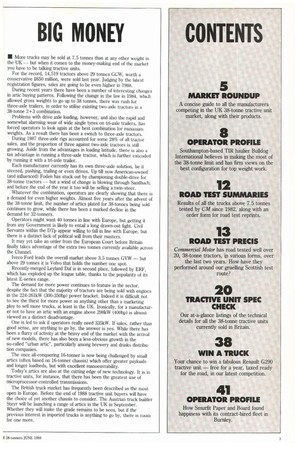BIG MONEY
Page 111

If you've noticed an error in this article please click here to report it so we can fix it.
NI More trucks may be sold at 7.5 tonnes than at any other weight in the UK — but when it comes to the money-making end of the market you have to be talking tractive units.
For the record, 14,519 tractors above 29 tonnes GCW, worth a conservative £650 million, were sold last year. Judging by the latest registration figures, sales are going to be even higher in 1988.
During recent years there have been a number of interesting changes in artic buying patterns. Following the change in the law in 1984, which allowed gross weights to go up to 38 tonnes, there was rush for three-axle trailers, in order to utilise existing two-axle tractors in a 38-tonne 2+3 combination.
Problems with drive axle loading, however, and also the rapid and somewhat alarming wear of wide single tyres on tri-axle trailers, has forced operators to look again at the best combination for maximum weights. As a result there has been a switch to three-axle tractors.
During 1987 three-axle rigs accounted for some 28% of all tractor sales, and the proportion of three against two-axle tractors is still growing. Aside from the advantages in loading latitude, there is also a tax advantage in running a three-axle tractor, which is further extended by running it with a tri-axle trailer.
Each manufacturer currently has its own three-axle solution, be it steered, pushing, trailing or even driven. Up till now American-owned (and influenced) Foden has stuck out by championing double-drive for 38-tonne tractors — but a wind of change is blowing through Sandbach, and before the end of the year it too will be selling a twin-steer.
Whatever the combination, operators are clearly showing that there is a demand for even higher weights. Almost five years after the advent of the 38-tonne limit, the number of artics plated for 38-tonnes being sold continues to grow, while there has been a marked decline in the demand for 32-tonners.
Operators might want 40 tonnes in line with Europe, but getting it from any Government is likely to entail a long drawn-out fight. Civil Servants within the DTp appear willing to fall in line with Europe, but there is a distinct lack of political will from their masters.
It may yet take an order from the European Court before Britain finally takes advantage of the extra two tonnes currently available across the Channel.
Iveco Ford leads the overall market above 3.5 tonnes GVW — but above 29 tonnes it is Volvo that holds the number one spot.
Recently-merged Leyland Daf is in second place, followed by ERF, which has exploded up the league table, thanks to the popularity of its latest E-series range.
The demand for more power continues to feature in the sector, despite the fact that the majority of tractors are being sold with engines in the 224-261kW (300-350hp) power bracket. Indeed it is difficult not to see the thirst for more power as anything other than a marketing ploy to sell more trucks, at least in the UK. Ironically, for a manufacturer not to have an artic with an engine above 298kW (400hp) is almost viewed as a distinct disadvantage.
One is led to ask if operators really need 335kW. If sales, rather than good sense, are anything to go by, the answer is yes. While there has been a flurry of activity at the heavy end of the market with the arrival of new models, there has also been a less-obvious growth in the so-called "urban artic", particularly among brewery and drinks distribution companies.
The once all-conquering 16-tonner is now being challenged by small artics (often based on 16-tonner chassis) which offer greater payloads and longer loadbeds, but with excellent manoeuvrability.
Today's artics are also at the cutting edge of new technology. It is in tractive units, for instance, that there has been the greatest use of microprocessor-controlled transmissions.
The British truck market has frequently been described as the most open in Europe. Before the end of 1988 tractive unit buyers will have the choice of yet another chassis to consider. The Austrian truck builder Steyr will be launching a range of artics in the UK in September. Whether they will make the grade remains to be seen, but if the previous interest in imported trucks is anything to go by, there is room for one more.
























































































































































